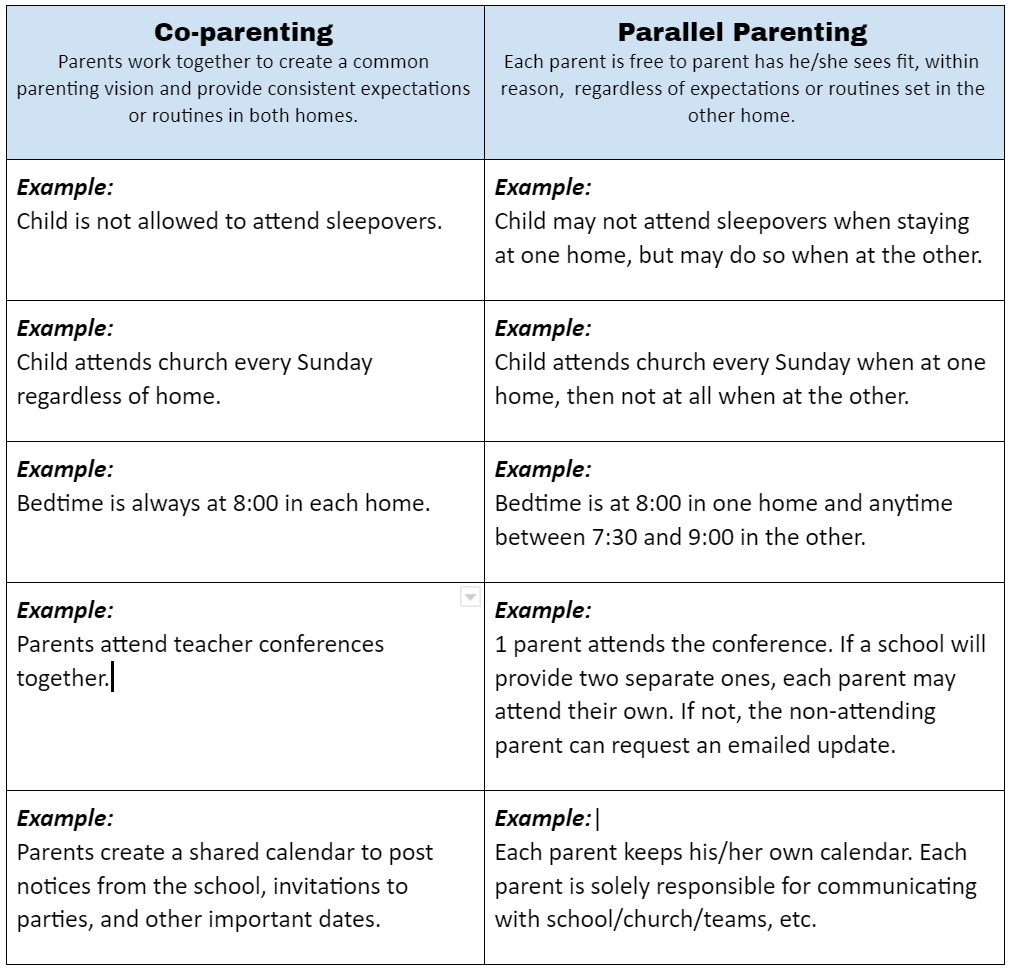Photo by Xavier Mouton Photographie on UnsplashCo-Parenting Co-parenting is all the rage. Conceptually, it is awesome. It requires two well-adjusted, divorced adults who are committed and able to put their personal hurt and emotions aside in the interest of working jointly in their child’s best interest. Co-parenting demands ongoing communication between the parents and regular interaction. It seeks to unify the parenting styles across the two households, and through consensus, to establish consistent, common routines and expectations in both homes. Ummmm...No Thanks? Does this sound like a nightmare to you? You’re not alone. In my world, as a divorce attorney who deals with many high conflict situations, the co- parenting model is an untenable pipe dream. In a high conflict relationship, parents are unable to effectively communicate productively at all. They definitely cannot set aside their own adult emotions and needs for the benefit of a child. Control is wielded as a tool of power, and even little compromises are unfathomable. Not even when a judge is involved. To minimize high-intensity interactions, some courts have ordered a very different parenting model, whereby the divorced couple each parent unilaterally during his or her respective parenting time with the primary benefit of minimizing interactions. Enter Parallel Parenting: First and foremost, parallel parenting is only employed when both parents are safe, mentally stable, sober, and healthy. If a child’s well-being is ever in question, contact a lawyer immediately to seek a temporary order. Safety first! Parallel parenting encourages minimal interaction or communication. Information is still shared, but almost all communications are via email (or some form of writing) to document the communication and eliminate live improvisation. Parallel parenting recognizes that there will be no consensus between the two estranged parents, and that each is capable of establishing healthy and reasonable routines, in their respective homes, with very little interaction. What Does This Look Like? 5+1 Parallel Parenting Must-Dos!
Let go of the guilt. All marriages and divorces are unique...and 10% of divorces are high-conflict. In most high-conflict divorces, one party is the antagonist due to mental illnesses and/or substance abuse. If you're reading this, odds are you're not the cause of the conflict. Parallel parenting is not a lesser-than strategy. It's not a give-up. Gwenyth Paltrow is not going to show up at your house to parent-shame you and discuss conscious uncoupling (ugh). Parallel parenting is a conscious and strategic technique to minimize unnecessary conflict with an antagonistic ex so you can save money and build a more peaceful future for yourself and your children. This article is not intended to determine which method is better, but to recognize that more than one option is available. Each family needs to avail themselves of the model that best fits their situation and needs. In many of my cases, co-parenting is NOT a viable option; in fact, it can be damaging to try. Parallel parenting is something that works for many families, and ultimately, can be in the best interest of the child.
4 Comments
Divorce parties are a thing around the world. You can read about them almost anywhere. Parents Magazine published an article in February about them. You can find thousands of Pinterest boards offering party planning ideas. In 2017, The Guardian shared a story about how planning a divorce party for her best friend turned her into full-time divorce party planner. In 2018, Glamour Magazine published an article about divorce parties, sharing their Twitter, Facebook, and Instagram hashtags and revealing shocking party price tags of up to $20,000. For a good laugh, you can even visit Buzzfeed to see 24 Hilarious Divorce Cakes That Are Even Better Than Wedding Cakes.
As a family law attorney, I’ve had several clients host divorce parties. In fact, a client whose divorce was finalized this month is planning one as I type this. In all of the cases I’ve experienced, divorce parties were not about celebrating divorce itself. Divorce, even in its most evolved iterations, is typically painful and disappointing on some level...certainly not party-prompting. Rather, the divorce parties I’ve witnessed are always about reconnecting with friends essential to moving life forward. They are also about providing closure to a painful but positive milestone in life. Maybe these parties are misnamed entirely. Phoenix parties? Lotus luaus? Gloria Gaynor galas? If you’re considering a divorce party of your own, or hosting one for a friend or family member, I have some practical suggestions to consider (I know - buzz kill family law attorney strikes again!). The majority of my clients are in high-conflict divorce situations...so I’m always sensitive to minimizing antagonism. In high-conflict situations, even the rumor of a ‘divorce party’ would prompt retaliation, venom, confrontation, or harassment. Outside of a high-conflict situation, in the world of relatively well-adjusted adults, news of a divorce party still has the potential to hurt feelings, cause discomfort, and burn bridges unnecessarily. In the spirit of moving forward positively...and doing no collateral harm...here are 5 divorce party recommendations:
Whether you’re a fan or not, divorce parties are a widespread reality around the world. Here’s to hoping that are supportive and future-focused celebrations that affirm life, strengthen friendships, and bring healthy closure to a complicated milestone! |
AuthorJason Castle is a family lawyer who specializes in high-conflict cases. He's also a former prosecutor & social worker. Hear his latest divorce thoughts! Archives
January 2024
Categories |





 RSS Feed
RSS Feed